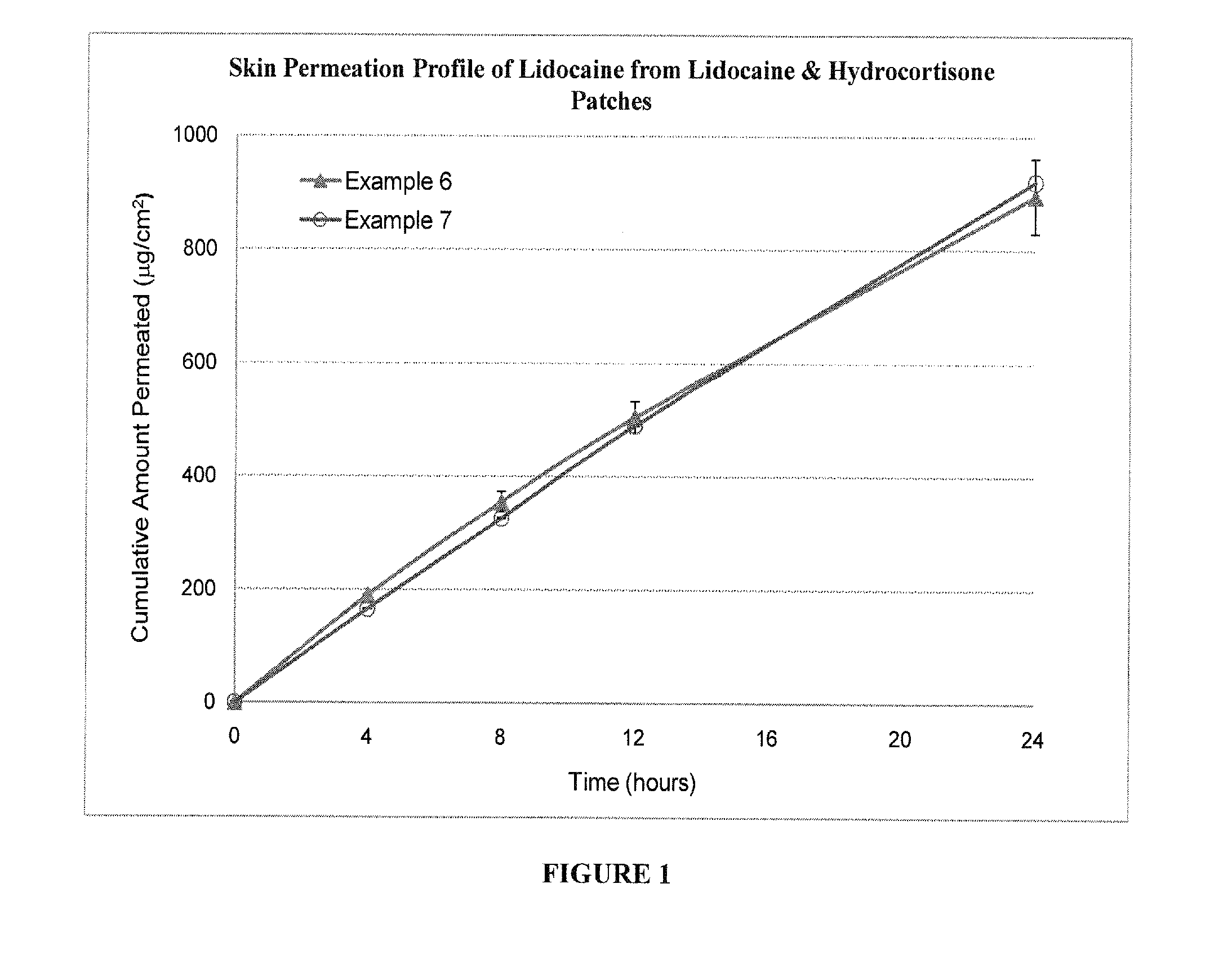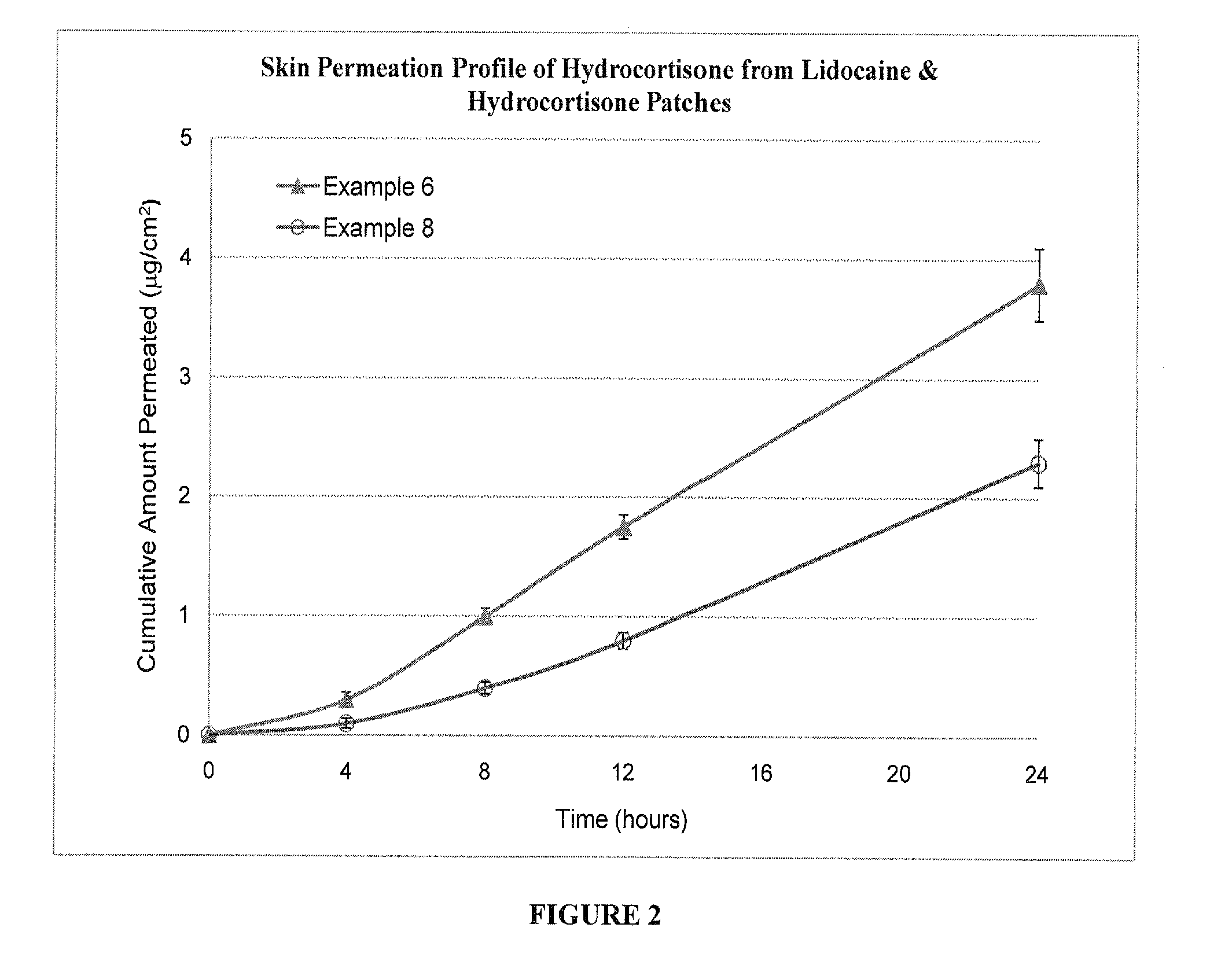Compositions and Methods of Topical Drug Delivery for the Treatment of Carpal Tunnel Syndrome
a carpal tunnel syndrome and topical drug technology, applied in the direction of drug compositions, biocide, bandages, etc., can solve the problems of carpal tunnel syndrome, ischemia of the nerve and its dysfunction, compression of the median nerve, etc., to facilitate the permeation of glucocorticoids through the skin, and reduce the risk of ischemia
- Summary
- Abstract
- Description
- Claims
- Application Information
AI Technical Summary
Benefits of technology
Problems solved by technology
Method used
Image
Examples
example 1
Preparation of the Transdermal Patches and Stability Samples
[0041]A transdermal delivery composition was prepared with the following ingredients:
Substance% (by weight)Lidocaine5.0Prednisone2.5Propylene Glycol10.0Gelva ® 737 Adhesive Solution (32.3% polyacrylate)82.5Total100.0Preparation of the transdermal patch:1. Weigh appropriate amounts of active pharmaceutical ingredients (e.g., lidocaine and prednisone), inactive ingredients (e.g., propylene glycol), and adhesive solutions (e.g., Gelva ® 737) accurately in a vessel.2. Dissolve or suspend the ingredients in the adhesive solution and mix the solution until homogeneous.3. Place a sheet of release liner onto a patch coater (e.g., Warner Mathis coater)4. Pour the solution on the release liner and coat a thin film on the release liner.5. Dry the solution in an oven at preset temperature for a predetermined time to evaporate the solvents.6. After drying, laminate the dried film with a sheet of backing layer.7. Cut the laminate with a ...
example 2
In Vitro Skin Permeation Studies
[0042]The lidocaine / prednisone patch as described in Example 1 is evaluated to determine the skin permeation of lidocaine. Lidoderm® is included in the study for comparison. Lidoderm® patch was cut into size of 1.5 cm×1.5 cm for the convenience of the skin permeation study. The drug loading of Lidoderm® patch is 700 mg / 140 cm2.
[0043]The in-vitro permeation of lidocaine patch through human cadaver skin was studied using VC (Valia-Chien) skin diffusion cells. The active permeation area for the study was 0.64 cm2. Human cadaver skin was cut to desired size and placed on a flat surface of one VC skin diffusion cell with the stratum corneum side facing outward. The release liner was separated from the polyacrylate drug matrix. The drug matrix was placed onto the stratum corneum. The same was repeated for another set of VC skin diffusion cell. The two sets were then clamped together. 10% polyethylene glycol in distill water solution of 3.5 mL was added to t...
example 3-11
[0045]Transdermal lidocaine / glucocorticoids delivery compositions were prepared according to the manufacturing procedures as described in Example 1 with the following ingredients:
Formulation IDSubstanceExample 3Example 4Example 5Lidocaine10.0%10.0%—Hydrocortisone (micronized)1.0%—1.0%Starch 150040.0%40.0%40.0%Polyacrylate (Gelva ® 737 / 49.0%50.0%59.0%Duro-Tak ® 87-2852 = 85 / 15)Total100.0%100.0%100.0%Formulation IDSubstanceExample 6Example 7Example 8Lidocaine10.0%10.0%—Hydrocortisone (micronized)1.0%—1.0%Starch 150040.0%40.0%40.0%Polyacrylate (Gelva ® 737)49.0%50.0%59.0%Total100.0%100.0%100.0%Formulation IDSubstanceExample 9Example 10Example 11Lidocaine10.0%10.0%10.0%Hydrocortisone (micronized)1.0%1.0%1.0%Starch 150040.0%40.0%40.0%Polyacrylate (Gelva ® 737 / 49.0%——Duro-Tak ® 87-2074 = 2 / 8)Polyacrylate (Gelva ® 788 / —49.0%—Duro-Tak ® 87-2074 = 2 / 8)Polyacrylate (Gelva ® 788)——49.0%Total100.0%100.0%100.0%
PUM
| Property | Measurement | Unit |
|---|---|---|
| size | aaaaa | aaaaa |
| permeation area | aaaaa | aaaaa |
| weight | aaaaa | aaaaa |
Abstract
Description
Claims
Application Information
 Login to View More
Login to View More - R&D
- Intellectual Property
- Life Sciences
- Materials
- Tech Scout
- Unparalleled Data Quality
- Higher Quality Content
- 60% Fewer Hallucinations
Browse by: Latest US Patents, China's latest patents, Technical Efficacy Thesaurus, Application Domain, Technology Topic, Popular Technical Reports.
© 2025 PatSnap. All rights reserved.Legal|Privacy policy|Modern Slavery Act Transparency Statement|Sitemap|About US| Contact US: help@patsnap.com


